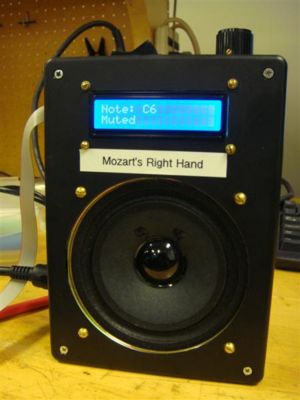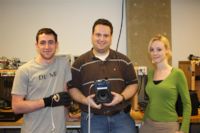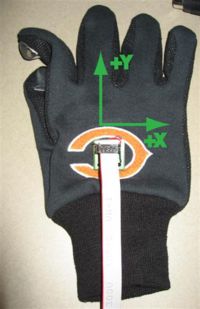Mozart's Right Hand
Introduction
Mozart's Right Hand is a musical instrument capable of playing two full octaves of the Diatonic Scale. The user wears a glove on his right hand and uses motions of the hand and fingers to create different notes that are played with a speaker. The pitch of the note is controlled by the orientation of the user's hand as he rotates it ether from the wrist, the elbow, or the shoulder. The LCD on the front of the box tells the user the pitch that corresponds to his or her current hand orientation. When the user touches together his thumb and index finger, the speaker plays the tone. A video of Mozart's Right Hand in action is available on YouTube.
The Team
- Colleen Fryer ( colleenfryer2008 at u dot northwestern dot edu ), Mechanical Engineering Graduate Student
- Sean Wood ( seanwood2010 at u dot northwestern dot edu ), Mechanical Engineering Junior
- Mat Kotowsky (kotowsky at northwestern dot edu), Civil Engineering Graduate Student
Theory of Operation
Mozart's right hand plays all of the notes, including sharps and flats, between and including C5 and C7 (where C4 is "Middle C"). Each of these notes has a specific frequency associate with it; for example: C6 has a frequency of 1046.50 Hz. Other notes' frequencies are available at http://www.phy.mtu.edu/~suits/notefreqs.html. If signal whose voltage is a 1046.50 Hz sine wave is passed through a speaker, the speaker will play C6. Increasing the frequency will raise the pitch, decreasing it will lower the pitch. Increasing the amplitude will cause the volume of the note to go up, decreasing it will cause the volume to go down.
Orientation of the Hand Relative to Gravity
The pitch of a note is decided by measuring gravitational acceleration in two axes. The Y-axis runs along the user's arm with positive being toward the fingertips. The X-axis is orthogonal to the Y axis and lies in the plan of the palm of the hand. The pitch is decided by first measuring the gravitational acceleration in the Y direction. If the Y acceleration is 0g, the palm is parallel to the floor. If the Y acceleration is 1g, the palm is perpendicular to the floor with the fingertips pointing towards the floor. If the Y acceleration is -1g, the plan is perpendicular to the floor with the fingertips pointed straight up. When the fingertips are pointed straight down (1g), Mozart's Right Hand produces its lowest possible note: C5. When the fingertips are pointed straight out (0g), it produces its mid-rage note: C6. When the fingertips are pointed straight up (-1g), it produces its highest possible note, C7.
The X-axis is used to determine whether a note is sharp or flat. If the X axis measures 0g, the note is played naturally with no sharps or flats. If the X axis measures a positive gravitational acceleration, the user is tipping his hand to the right and the note is played sharp. If the X axis measures a negative gravitational acceleration, the user is tipping his hand to the left and the note is played flat.
For both the X and Y axes, the actual values used to determine the thresholds between notes were determined empirically. They appear in the code below.
Effect of Centripetal Acceleration
During typical use, the user's hand remains stationary and the only effect on the pitch is the glove's orientation with respect to gravity. It is possible, however, that the user will want to play a note while simultaneously moving his hand. The speaker will play different tones as the user moves his hand through the different orientations. During this type of playing, the acceleration measured by the accelerometer is not only due to gravity but due to the effect of centripetal force caused by the hands rotation about the user's wrist, elbow, or shoulder. If one assumes that such motion is uniform and circular about its center, then the acceleration measured during motion is a superposition of the acceleration due to gravity and the acceleration toward the center of rotation: ![]() .
.
The average length of a human hand is approximate 180mm (from http://en.wikipedia.org/wiki/Hand), so the distance between the accelerometer and the wrist is about half of that: 90mm. If the fastest a user moved his hand from straight down to straight up is one second, its total distance traveled would be one half of the circumference of a circle with a radius of 90mm: approximately 280mm, for a velocity of about 280mm per second. Therefore, the acceleration towards the wrist would be approximately 0.9 meters per second squared. This is lest than one tenth of a g, so a user would not experience a significant change in note pitch due to centripetal acceleration while rotating at the wrist.
The same calculation could be carried out for playing Mozart's Right Hand by rotating through the elbow or the shoulder.



